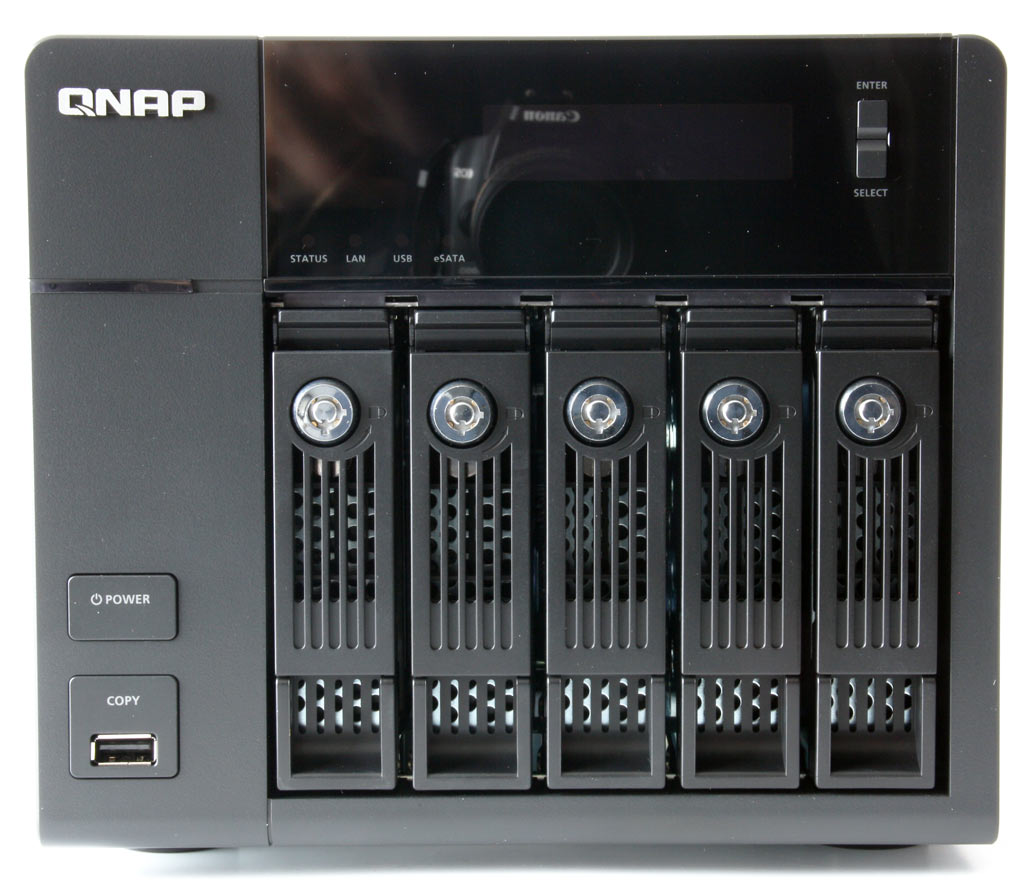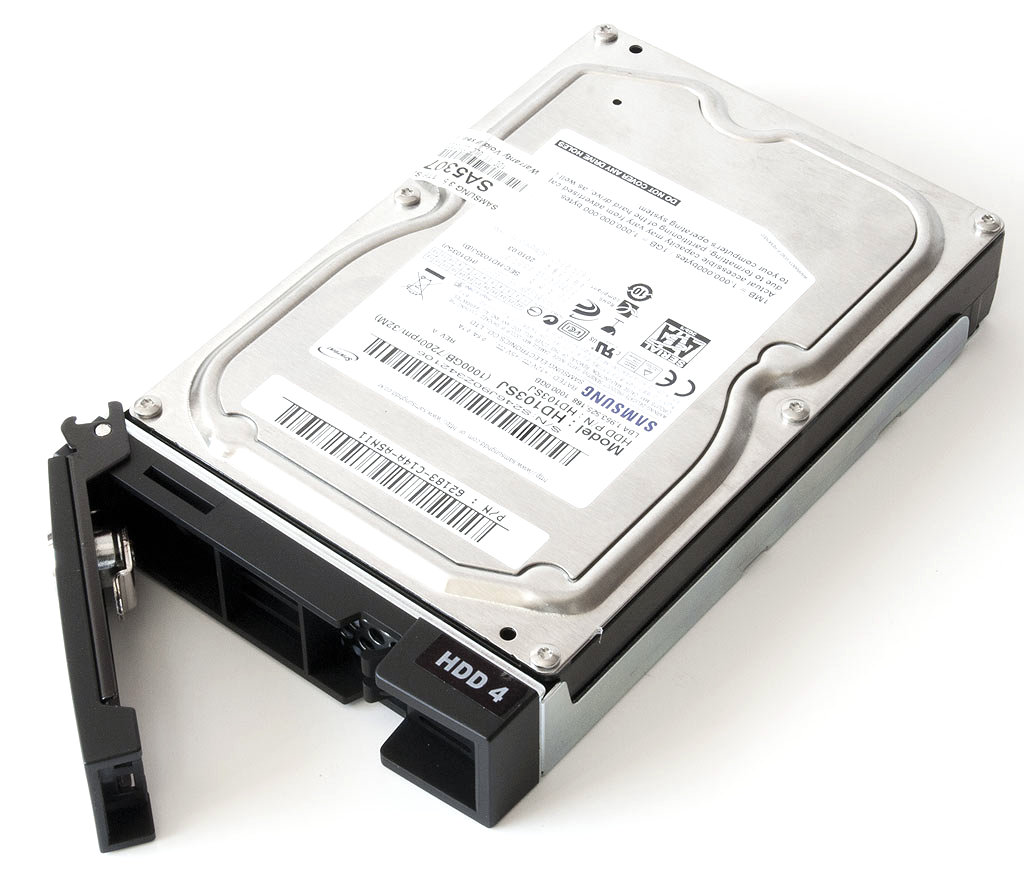Qnap TS-559 Pro+: Familiar Network Storage With A New CPU
It’s a good idea to use two CPU cores to speed up multiple drives in RAID 5 or 6 arrays and it’s even better to increase clock speeds. We put Qnap's TS-559 Pro+ with an Atom D525 dual-core CPU to the test: is it any faster than devices with Atom D510?
Sticking With What Works
If you're hoping to find new features on the front of the devices, we have to disappoint you. As with the rear of the device, the design of the plastic-covered front is reminiscent of the TS-559 Pro. The new model also comes with a USB 2.0 port and a one-touch copy button. The power button at the lower-left is also in the same location as on the previous model. Ditto for the status, LAN, USB, and SATA LEDs, along with the LCD display and its Enter/Select button, which switches the information shown on the LCD and allows for basic input, such as IP address configuration.
Qnap's deliberate reproduction of the TS-559 Pro's exterior design indicates that the manufacturer intends only to refresh and not to overhaul the product line, as can also be seen with the lockable drive bays. These are also installed vertically into the TS-559 Pro+, following the design of the TS-559 Pro model. Accordingly, the solid disk tray accommodates not only 3.5" hard drives, but also 2.5" drives.
The Interior Is New
If you're looking for fresh features on the TS-559 Pro+, you have to look inside. As already mentioned, the Intel Atom D525 dual-core processor is new. The TS-x59 Pro series used the somewhat older Intel Atom D510 with its clock rate of 1.66 GHz, while the TS-x59 Pro+ series runs at 1.8 GHz thanks to the upgraded processor. A glance into the interior reveals that the TS-559 Pro+ uses the same DDR2 memory as its predecessor. Qnap doesn’t highlight this fact; the product description on its Web site speaks only of 1 GB of RAM, omitting to mention which type of RAM this is. To avoid creating false hopes, we would appreciate a little more transparency in this matter.
However, the question of whether DDR3 RAM would have had a significant effect on data transfer rates is an unresolved one. From a business standpoint, it is fully comprehensible that Qnap does not opt for DDR3, as it would have required a redesigned motherboard. Aside from the fact that DDR2 and DDR3 are supplied with different voltages, they are not pin-compatible. In the end, a new board may have resulted in a more substantial redesign of the NAS system, incurring development costs, which would have probably driven the device beyond its already-steep $1000+ price tag.
Get Tom's Hardware's best news and in-depth reviews, straight to your inbox.
Current page: Sticking With What Works
Prev Page Hardware And Pricing Details Next Page A Glance At The Software And Specifications-
hmp_goose I remember a time when teh Internet was going to have hyperlinks embedded in articles for clowns like me to look stuff up with.Reply
C'mon! I'm a knuckle-dragging FPS-player: I don't know what "SMB/CIFS protocols" stands for, let alone good for! Isn't there at lest a related article? -
barmaley Ok, I don't get it. Can someone explain to me why this $1000 device that comes with no storage is better than a $500 Linux box you can build yourself that will do everything this does and more plus it will come with tons of storage too...Reply -
sharpless78 barmaleyOk, I don't get it. Can someone explain to me why this $1000 device that comes with no storage is better than a $500 Linux box you can build yourself that will do everything this does and more plus it will come with tons of storage too...Reply
Ease of use. Very few users have the time, will and knowledge to build a NAS. -
aaron88_7 barmaleyOk, I don't get it. Can someone explain to me why this $1000 device that comes with no storage is better than a $500 Linux box you can build yourself that will do everything this does and more plus it will come with tons of storage too...First off, it isn't better than a $500 Linux box. Linux requires Linux knowledge and you have to provide the software you need yourself - that costs small businesses money. This also offers failover and load balancing with its dual NIC card that you wouldn't have in a $500 Linux box.Reply
The main thing is ease of installation. You don't need a highly technical person to get this box up and running and quickly backing up your companies data, whereas a Linux machine will require additional staff that a small business normally would not have on hand and have to pay to come onsite.
For $1000 I'd like one just to play around with myself, though it clearly is not targeted for home users. -
dealcorn I am not aware of any 5 bay hot swap itx case that could be used as a basis for a diy project with comparable functionality. Chenbro can get you to 4 at the cost of no pcie support. No pcie means no esata with a supermicro atom itx board.Reply
There are ways to go with ATX cases, but that is not really comparable. -
radiumburn but with that $500 linux box you will force yourself to learn something.. and in the end isn't it all about the pursuit of knowledge! haha well I admin a few linux servers so I'd save the cash and make my own for myself/work instead. On that note if you want I will make them for $999 and free shipping with initial phone setup!!! save a dollar!Reply -
a-nano-moose How can you compare them when you are using different hard drives than the earlier tests?Reply -
cknobman Sharpless78Ease of use. Very few users have the time, will and knowledge to build a NAS.Reply
A NAS is a computer. Heck you can even build a PC put Windows 7/XP Home edition on it and turn it into a NAS all for ~$500 (and thats even with 2tb storage in raid 1, heck that is what I have done and it works great and I am even using a low power AMD CPU that is powerful enough to actually be useful rather than a pathetic atom cpu).
There is no ease of use factor or amount of time on earth that is worth $500+ dollars.


